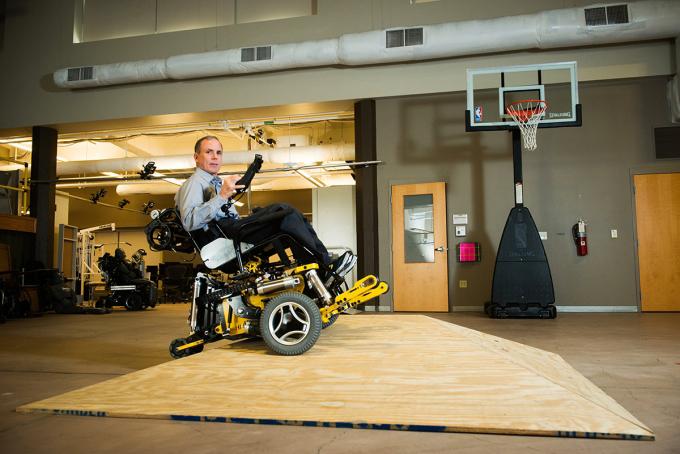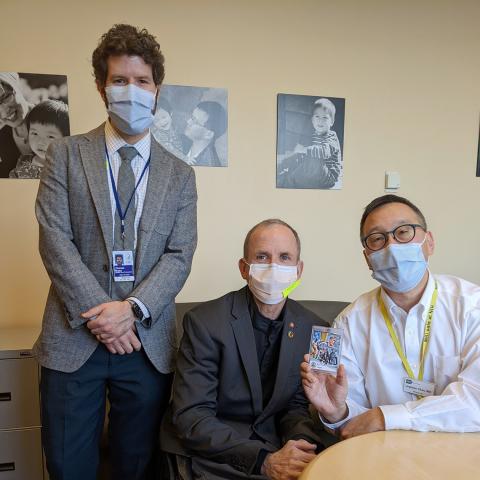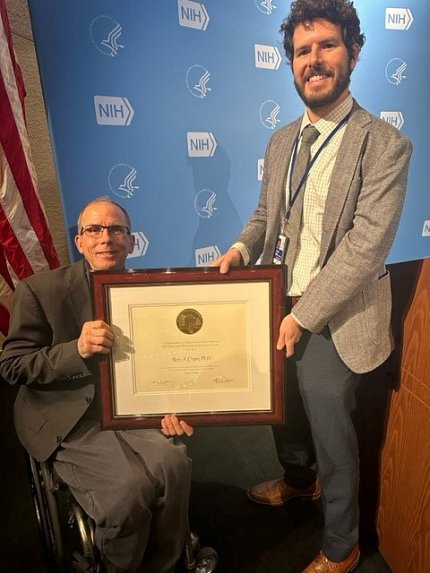Inclusivity Not Optional for HERL

Photo: UC Santa Barbara
The first Wednesday Afternoon Lecture Series lecturer of 2023 was introduced by host Dr. Tom Bulea as “maybe the only WALS speaker to be featured on a Cheerios box” (although the jury is technically still out on Dr. Fauci).
Dr. Rory Cooper is a bioengineer and founding director of the Human Engineering Research Labs (HERL) at the University of Pittsburgh and U.S. Department of Veterans Affairs. HERL’s mission is to improve the mobility and function of people with disabilities through advanced engineering in clinical research and medical rehabilitation. Cooper recently shared his perspective with the NIH community in a hybrid lecture titled “Forging a New Future: Inclusion of People with Disabilities in Technology Research and Development.”
One in seven Americans has a disability that impairs their daily life—including Cooper. After sustaining a spinal cord injury during military service at the age of 20, he became reliant on a wheelchair he described as “an 80-pound behemoth.”

His new reality made him realize the “tremendous need” to improve the technologies, environments and perceptions of people with disabilities. He set out to become an engineer, earning bachelor’s and master’s degrees in electrical engineering from California Polytechnic State University and a Ph. D. in electrical and computer engineering with a concentration in bioengineering from the University of California, Santa Barbara.
Cooper founded HERL in 1994 after several years of teaching at Sacramento State University. The HERL view is that research must include the people you are trying to help as members of the team. That perspective comes not only from Cooper, but also from many of the other members of his lab.
According to the National Council on Disability, being involved in planning from day one is critical to building an accessible product. Cooper and his lab recruitment team vigorously work to incorporate people with disabilities in research and development. That involves interviewing and surveying end users to set priorities, as well as including them in the research process.
The Pitt HERL ELeVATE (Experiential Learning for Veterans in Assistive Technology and Engineering) program, for example, provides internships for military veterans to conduct research in the lab. HERL also recruits from many other sources.
“[Recruiting] has gotten easier over time because word has gotten out,” Cooper added.
He has also designed the HERL facility to be an ideal workplace for people with disabilities.

Photo: Diana Gomez
“We look at what people need to be productive, rather than [just] what the ADA guidelines say,” he said. That involves modifications like wider hallways and lower lab benches.
Inclusivity is a priority at HERL and that is reflected in the diversity of abilities in the lab. But the community of people with disabilities is underrepresented in STEM education. Cooper found three contributing factors: lack of accessibility in labs; lack of knowledge on accessibility and inclusivity among educators and scientists; and lack of access to science classes in high school.
He found that labs and other facilities generally are not truly adapted or outfitted for people with disabilities, and teachers and scientists are often not educated on how to accommodate people with disabilities.
Additionally, some states do not require science education after middle school, so fewer students in those states may be directed toward STEM careers as a result.
In Cooper’s experience, he has found that “a lot of knowledge is lost if you don’t include the people you are trying to help in your research.”
Ergonomics
HERL research covers several domains, which include health and the prevention of secondary conditions. Some of the most common injuries in wheelchair users include carpal tunnel and rotator cuff injuries. Cooper wanted to study wheelchair ergonomics to reduce these injuries.
“I also wanted to increase my odds of winning a medal in Paralympics wheelchair racing,” he joked (Cooper has won 200-plus medals in various wheelchair sporting events, hence the Cheerios box feature).
In the 1990s and 2000s, about 80% of wheelchair users developed carpal tunnel or rotator cuff injuries within 5 years, which they said was just as devastating as their initial injury. Cooper and his colleagues developed a more ergonomic push rim for wheelchairs.
Originally, users propelled themselves with a pinch grip, which increased their injury risk. But Cooper’s team’s new design changed to a tool grip, which is more powerful, efficient and reduces risk of overuse injuries. Most important to wheelchair users, better wheelchairs, fitting and the modified grip reduce the incidence of carpal tunnel and rotator cuff injuries to about 20%.
HERL also developed—with NIH funding—the SMARTWheel, a device mounted on the wheel that measures push forces, frequency, length, smoothness and speed. The mechanism provides automated reports and assists therapists in optimizing wheelchair setup and push style while also reducing repetitive stress. The SMARTWheel enabled the research leading to improved wheelchair ergonomics worldwide, and has become the “gold standard” for research teams.
Wheelchair users experience whole-body vibrations on the same scale as helicopter pilots and long-haul truckers, which can cause back and neck problems. HERL is currently investigating in-wheel suspension devices to reduce these vibrations.
Technologies Meet Engineering
“When you conduct work in a lab, you learn what people can do,” Cooper said, “but what you don’t learn is what they do do.”
To address this disconnect, HERL develops software and other virtual coaching technologies that can be used at home. One example is the Virtual Seating Coach app, which connects to sensors in the wheelchair seat. The “virtual coach” analyzes how the user is sitting and advises users how to adjust to avoid pressure injuries.
A similar product, Active Cushion, is still in the works. It is a collaboration with the University of Texas Applied Research Institute. The product is an air bladder cushion with modulating algorithms that analyze users’ sitting pressure patterns and use that data to redistribute pressure more evenly across the seat.

Another focus of the lab is transfer, which involves moving a patient to/from a wheelchair, bed, car or other setting, often with the assistance of a caregiver or trained health care professional.
HERL researchers modified the gaming technology Microsoft Xbox Kinect to build a program that can educate wheelchair users and caregivers on transfer training in their own homes. The software, TransKinect, is affordable and readily available.
HERL is also working on powered transfer devices, such as a robotic arm that lifts patients with a sling, and a hospital bed that can link to a powered wheelchair and move a patient between the two devices unassisted.
Future Targets and Takeaways
Future goals for HERL include building technologies to help people retain or regain their autonomy.
Much of that revolves around car technology, because “people usually stop driving when they develop a mobility-impairing disability,” Cooper said. Expanding upon technologies like lane control and adaptive cruise control, which are already in many new vehicles, could help people with disabilities maintain their independence.
Technologies like these benefit able-bodied people as well, which is a crucial takeaway Cooper wants people to remember.
“Everyone prefers the more accessible facilities,” he said—think family bathrooms, automatic doors, ramps, etc.
Think of reimagining spaces and equipment as “a universal design approach that makes the world a better place for everyone,” he concluded.
To view a recording of the full lecture, visit https://videocast.nih.gov/watch=46052.
